Intel Broadwell Architecture Preview: A Glimpse into Core M
by Ryan Smith on August 11, 2014 12:01 PM ESTPutting It All Together: Low Power Core M
So far we’ve discussed Broadwell’s architecture on a broad basis, focusing on features and optimizations that are fundamental to the architecture. However to talk about the Broadwell architecture is not enough to fully explain the Core M itself. Though many of Core M’s improvements do come from Broadwell, Intel has also made a number of alterations to everything from the CPU packaging to the process node itself specifically for Core M. It’s the resulting combination of these factors that has allowed Intel to iterate on Broadwell-Y over Haswell-Y, and why Intel is so confident in Broadwell-Y’s capabilities and suitability for mobile form factors.
When it comes to building and configuring Core M, Intel likes to refer to their efforts as the “Fanless Challenge,” reflecting the fact that their biggest goal with Core M is to comfortably get the processor in to 10” tablets under 10mm in thickness that are passively cooled. A big part of getting into such a device is meeting the heat dissipation limitations of the form factor – a 10” tablet under 10mm would require a sub-5W SoC – which is where a lot of Intel’s engineering efforts have gone. Broadwell’s performance optimizations, the GPU optimizations, GPU duty cycling, and the 14nm process all contribute to getting a Core CPU’s power consumption down to that level.
But even that’s still not enough, and for Core M Intel went so far as to give Broadwell-Y its own die and design a low-power optimized version of their 14nm process just for it. This variant is designed to further reduce power consumption by optimizing the resulting transistors for lower power, lower voltage, lower clockspeed operation. By doing this Intel was able to further reduce power consumption in all of the major areas over what would be a traditional 14nm Intel process.
In the resulting 14nm Broadwell-Y process, voltage, capacitance, and leakage were all improved over the traditional 14nm process. Capacitance was reduced by 15%, minimum operating voltages by 10%, and leakage was improved to the point that it reduced SoC power consumption by 10%. The combination of all of these factors serves to significantly lower power consumption over what Intel’s traditional 14nm process would provide.
Working in concert with Broadwell-Y’s 14nm process, Intel has made a number of other changes to further reduce power consumption. Some of these are reflected in Broadwell’s overall design and others are unique to Broadwell-Y, such as using a lower TjMax for Broadwell-Y. By reducing the maximum operating temperature of the chip Intel has been able to realize further power savings by further reducing voltage and decreasing the maximum amount of temperature-dependent leakage the SoC will experience.
Meanwhile Broadwell-Y’s partner in crime, the on-package PCH, has received its own optimizations to reduce power consumption on the SoC’s total power consumption. The PCH itself is not much of a power hog in the first place – it’s still made on Intel’s 32nm process for this and cost reasons – but with such a strong focus on power consumption every watt ends up counting. As a result the Broadwell PCH-LP has seen optimizations that cut its idle power consumption by 25% and its active power consumption by 20%. Further improvements to the PCH’s monitoring hardware also mean it’s more responsive and can be controlled to a finer degree than the Haswell PCH-LP, and Intel has upgraded to a faster audio DSP to improve performance and reduce power consumption there as well.
Feeding all of that silicon in turn is Intel’s second generation Fully Integrated Voltage Regulator (FIVR), which further builds off of Intel’s other optimizations. The 2nd gen FIVR has been tuned for Broadwell-Y’s lower voltages, making the FIVR itself more efficient when delivering power at those voltages. To accomplish this Intel has implemented non-linear vDroop control, which is designed to better control the voltage when workload changes would cause voltage overshoots that waste power. And when even the 2nd gen FIVR isn’t efficient enough, this latest FIVR offers a second mode (LVR Mode) for low voltage/workload situations where the FIVR can be partially bypassed to reduce the FIVR’s power consumption.
Interestingly Broadwell-Y also sees the voltage regulation inductors redesigned and relocated in both the name of power efficiency and space efficiency. We’ll get to the case of space efficiency in a moment, but for power efficiency the new 3D inductors (3DLs) have been placed on the underside of the package, allowing the use of more efficient inductors that waste less power.
This brings us to the final element of Intel’s power optimization efforts, which involve further adjustments to turbo boost as part of Intel’s “hurry up and go to sleep” motto. New for Broadwell-Y is a 3rd power state, PL3, which allows for even greater turbo boosting, but for only a very limited period of time – on the order of milliseconds. PL3 represents the maximum amount of power the device battery can deliver, and while it’s okay to reach this value sparingly, PL3 is a fast drain that is very hard on the battery. The existence of PL3 in this case is as much for battery protection as it is for performance; it allows devices to tap into PL3 power levels on occasion, all the while allowing PL2 (the regular burst limit) to be defined at a safer value below the battery’s limit. Put another way, by knowing PL3 devices know how to stay farther away from it, which in the long run is what’s best for battery reliability.


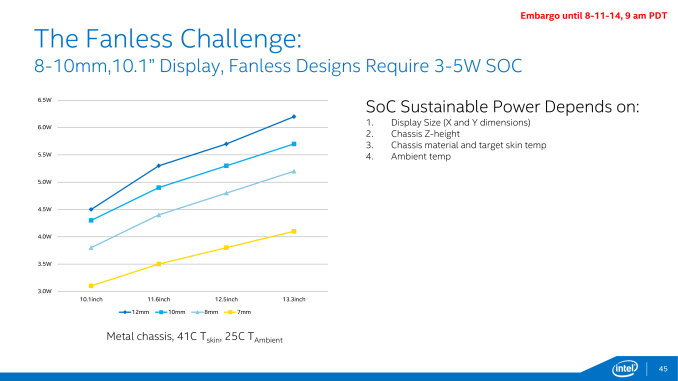
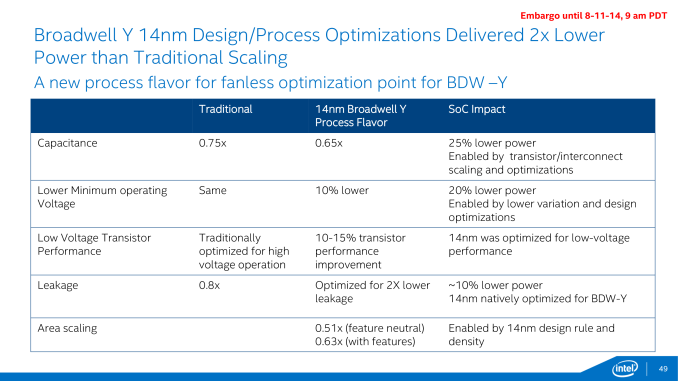
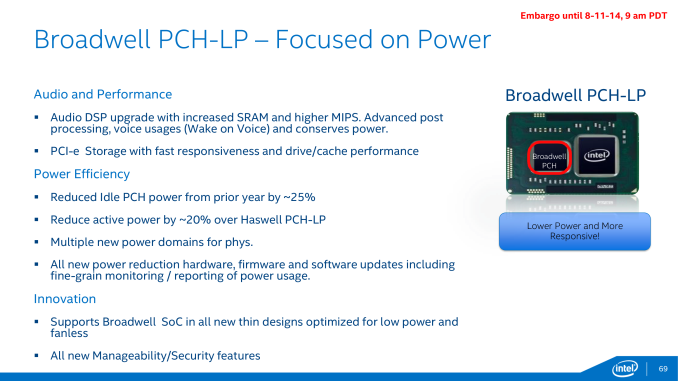
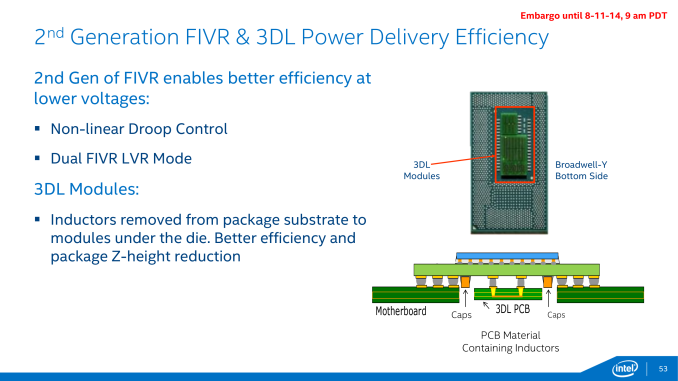

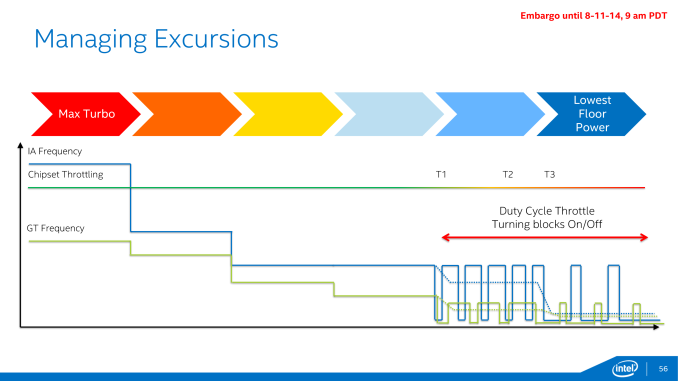








158 Comments
View All Comments
wurizen - Monday, August 11, 2014 - link
well, an fx-8350 is toe-to-toe with an i7-2600k, which is no slouch until today. and comparing fx-8350 with today's i7-4770k would be a little unfair since the 4770k is 22nm while the 8350 is at 32nm. and we're not even considering software optimizations from OS and/or programs that are probably bent towards intel chips due to its ubiquity.so, i think, you're wrong that the fx-8350 doesn't provide good enough. i have both i7-3770k oc'd to 4.1 ghz and an fx-8320 at stock and the amd is fine. it's more than good enough. i've ripped movies using handbrake on both systems and to me, both systems are fast. am i counting milliseconds? no. does it matter to me if the fx-8320 w/ lets say amd r9-290 has 85 fps for so and so game and an i7-4770k w/ the same gpu has a higher fps of 95, let's just say? i don't think so. that extra 10 fps cost that intel dude $100 more. and 10 extra frames with avg frames of 85-95 is undecipherable. it's only when the frames drop down below 60 does one notice it since most monitors are at 60 hz.
so what makes the fx not good enough for you again? are you like a brag queen? a rich man?
frostyfiredude - Monday, August 11, 2014 - link
Not fair to compare against a 22nm from Intel? Bogus, I can go to the store and buy a 22nm Intel so it should be compared against AMDs greatest. An i5-4670K matches or exceeds the performance of even the FX-9590 in all but the most embarrassingly threaded tasks while costing 50$ more. Cost to operate the machine through the power bill makes up for that price difference at a fairly standard 12c per KWh when used heavily 2 hours per day for 4 years or idling 8 hours per day for the same 4 years.Your argument for gaming with the 8350 being good enough is weak too when the 10$ cheaper i3-4430 keeps up. Or spent 125$ less to get a Pentium G3258 AE, then mildly overclock it to again have the same good enough gaming performance if >60FPS is all that matters. The i3 and pentiums are ~70$ cheaper yet when power use is counted again.
wurizen - Tuesday, August 12, 2014 - link
well, if a pentium g3258 is good enuff for gaming, then so is an fx-8350. whaaaaaat? omg we know intel is king. i acknowledge and understand that. intel rules. but, amd is not bad. not bad at all is all im trying to make./omg
wetwareinterface - Monday, August 11, 2014 - link
wow...first off you are assuming a lot and not bothering to check any published benchmarks out there so,
1. 8350 isn't even equal to 2500 i5 let alone 2600 i7.
2. 32nm vs. 22nm means nothing at all when comparing raw performance in a desktop. it will limit the thermal ceiling so in a laptop the higher nm chip will run hotter therefore be unable to hit higher clocks but in a desktop it means nil.
3. handbrake ripping relies on speed of dvd/blu-ray drive, handbrake transcoding relies on cpu performance and the 8350 gets spanked there by a dual core i3 not by miliseconds but tens of seconds. i5 it gets to the level of minutes i7 more so.
4. let's say you're pulling framerates for an r9-290 out of somewhere other than the ether... reality is an i5 is faster than the 8350 in almost any benchmark i've ever seen by roughly 15% overall. in certan games with lots of ai you get crazy framerate advantages with i5 over 8350, things like rome total war and starcraft 2 and diablo 3 etc...
i'll just say fx8350 isn't good enough for me and i'm certainly not a rich man. system build cost for what i have vs. what the 8350 system would have run was a whopping $65 difference
wurizen - Tuesday, August 12, 2014 - link
#3 is B.S. a dual-core i3 can't rip faster than an fx-8350 in handbrake.#4 the r-290 was an example to pair a fairly high end gpu with an fx-8350. a fairly high end gpu helps in games. thus, pairing it with an fx-8350 will give you a good combo that is more than good enough for gaming.
#2 22nm vs. 32nm does matter in desktops. the fx-8350 is 32nm. if it goes to 22nm, the die shrink would enable the chip to either go higher in clockspeed or lower it's tdp.
u sound like a benchmark queen or a publicity fatso.
wurizen - Tuesday, August 12, 2014 - link
oh and #1--i am not saying the fx 8350 is better than the i7-2600k. i said "toe-to-toe." the i5-2500k can also beat the fx-835o b/c of intel's IPC speed advantage. but, i think the reasons for that are programs not made to be multithreaded and make use of fx-8350 8-cores to it's potential. since amd trails intel in IPC performance by a lot--this means that a 4-core i5-2500k can match it or sometimes even beat it in games. in a multithreaded environment, the 8-core fx-8350 will always beat the i5-2500k. although it might still trailer the 4-core + 4 fake cores i7-2600k. just kidding. lol.i said toe to toe with 2600k which means its "competitive" to an i7-2600k even though the AMD is handicapped with slower IPC speed and most programs/OS not optimize for multithreading. so, to be 10-20% behind in most benchmarks against an i7-2600k is not bad considering how programs take advantage of intel's higher IPC performance.
do u understand what im trying to say?
Andrew Lin - Tuesday, August 26, 2014 - link
i'm sorry, is your argument here that the FX-8350 is better because it's inferior? because that's all i'm getting out of this. Of course a benchmark is going to take advantage of higher IPC performance. That's the point of a benchmark: to distinguish higher performance. The way you talk about benchmarks it's as if you think benchmarks only give higher numbers because they're biased. That's not how it works. The benchmarks give the i7-2600k higher scores because it is a higher performance part in real life, which is what anyone buying a CPU actually care about. Not to mention the significantly higher efficiency, which is just an added benefit.Also, it's really hard to take you seriously when your posts make me think they're written by a teenage girl.
wurizen - Tuesday, August 12, 2014 - link
also, if the fps disparity is so huge btwn fx-8350 and say i5-2500k in games u mention like starcraft 2, then something is wrong with that game. and not the fx-8350. i actually have sc2 and i have access to a pc w/ an fx-8320. so i am going to do a test later tonight. my own pc is an i7-3770k. so i could directly compare 2 different systems. the only thing is that the amd pc has an hd5850 gpu, which should be good enuff for sc2 and my pc has a gtx680 so it's not going to be a direct comparison. but, it should still give a good idea, right?wurizen - Tuesday, August 12, 2014 - link
i just played starcraft 2 on a pc with fx-8320 (stock clockspeed), 8GB 1600Mhz RAM, 7200rpm HDD and an old AMD HD5850 w/ 1GB VRAM. the experience was smooth. the settings were 1080P, all things at ultra or high and antialiasing set to ON. i wasn't looking at FPS since i don't know how to do it with starcraft 2, but, the gameplay was smooth. it didn't deter my experience.i also play this game on my own pc which is an i7-3770k OC'd to 4.1, 16GB 1600 Mhz RAM, 7200rpmHDD and an Nvidia GTX680 FTW w/ 2GB VRAM and i couldn't tell the difference as far as the smoothness of the gameplay is concerned. there is some graphical differences between the AMD GPU and the Nvidia GPU but that is another story. my point is that my experience were seamless playing on an FX chip pc to my own pc with 3700k.
to make another point, i also have this game on my macbook pro and that is where the experience of playing this game goes down. even in low settings. the MBP just can't handle it. at least the one i have with the older gt330m dGpu and dual-core w/ hyperthreading i7 mobile cpu.
so.... there.... no numbers or stats. just the experience, to me, which is what counts did not change with the pc that had the amd fx cpu.
wurizen - Tuesday, August 12, 2014 - link
well, i should point out that my macbook pro (mid-2010 model) can handle starcraft 2. but, it's not a "fun" experience. or as smooth.